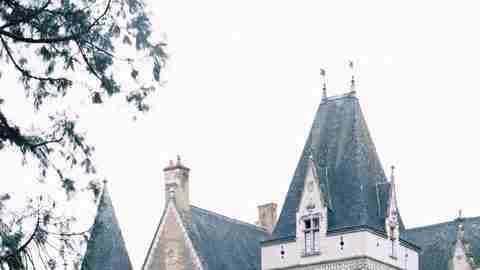Timothy Corrigan's Loire Valley Retreat
View Slideshow

The quickest, surest way of absorbing the culture of France would be to buy one of its great historic houses, redesign it for life in the 21st century, then assume your role as the latest in a long line of lords of the manor. Radical and risky as the move might sound, this is exactly what Los Angeles-based designer Timothy Corrigan did a couple of years ago. Today, with a much-improved grasp of all things French, the tall, energetic American is not only thriving in his European experience but looking for ways to spend more time in the ancient château that he has skillfully brought back to life.
"I was so caught up in the whole adventure that I didn't really think of the risks attached," Corrigan says. "I'd lived in France before, and I'd bought and redesigned a couple of other properties—but nothing on this scale. From the beginning I knew I was looking for something exceptional. It wasn't about needing a place to live; it was more about fantasy."
Corrigan concentrated on the Loire Valley "because there is so much fantastic architecture here," he says. "I visited lots of houses before I chanced on Château de Gallerande. When I first saw the setting of the place, and later when I was left to wander through one paneled room after another, I felt a kind of magic, as if I had gone into a different realm. There was no looking back."
What Corrigan sensed was that the building that stood before him, with its fortified towers and impenetrable walls, was much more than a fine house in beautiful surroundings. Over many centuries and countless twists of fate, the château had come to represent a sizable slice of French history—as its new owner was quick to learn. "I think of a house as the sum of the people to have lived in it," he says. "One of Gallerande's first owners had fought in the Crusades. In the 13th century the Gallerande family married into the powerful Clermont family, and the château remained their ancestral home for some 600 years, until Louise de Clermont-Gallerande, one of the renowned beauties of her day, gambled it away in a 1772 card game.
"The story doesn't end there, of course," Corrigan continues. "Most of the original fortress had been torn down in the 15th century to make way for a grand château, which was extensively remodeled in the mid•19th century by Count Geoffroy de Ruillé. The last family member to been brought to this country."
Somewhat less entrancing than the tales of Gallerande's past, Corrigan was to discover, was the château's overall state. "I won't pretend there wasn't a horrendous amount to do," he admits. "That was to be expected."
The designer hired craftsmen in the area who were able to modernize the château without drastically altering or damaging its basic structure. "There's a delicate balance in respecting an old building and making it comfortable," he says. "Achieving that balance became my rule of thumb for the whole renovation. You have to honor what's there while making it work for the way we live today—which includes a lot more bathrooms."
In all his projects, Corrigan favors an eclectic mix of styles and periods. From an early age he felt equally at home with his grandparents' antique furniture and his father's contemporary art. "I find hanging a Lichtenstein or a Stella over an antique commode creates a kind of energy and tension that you simply don't get when everything comes from one country and one point in time," Corrigan explains. "I'm no purist, and I feel that if you can successfully couple a piece of Art Déco furniture and a classical painting, the whole ambience becomes more inventive and more vibrant. I've spent half my life going around to galleries and auctions, antiques dealers and flea markets, in search of things that might interest me, and now I'm lucky to have a sufficiently large stock that I can choose from each time I undertake a new interior."
For Gallerande, Corrigan felt "particularly free, because I only really had myself to please," he says. "So I indulged my taste for contrasts by coloring some of the boiserie acid green and bright yellow to bring out the mellowness of the antiques. I especially like the idea that you can walk into a room and see something quite unexpected."
Yet the atmosphere at Château de Gallerande remains very much that of a grand European house, with the American designer's more daring touches being integrated into a harmonious and predominantly traditional whole. "Even though I like to shake things up a little," Corrigan says, "I aim for a kind of look that usually takes generations to achieve. To be surrounded by history but live in it on my own terms is for me like having a long-held dream come true."